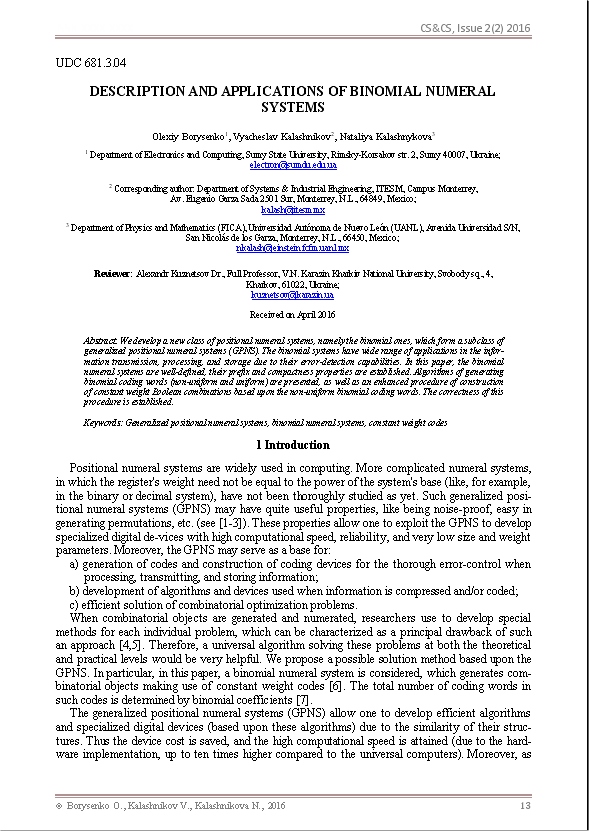Description and applications of binomial numeral systems.
Abstract
We develop a new class of positional numeral systems, namely the binomial ones, which form a subclass of generalized positional numeral systems (GPNS). The binomial systems have wide range of applications in the information transmission, processing, and storage due to their error-detection capabilities. In this paper, the binomial numeral systems are well-defined, their prefix and compactness properties are established. Algorithms of generating binomial coding words (non-uniform and uniform) are presented, as well as an enhanced procedure of construction of constant weight Boolean combinations based upon the non-uniform binomial coding words. The correctness of this procedure is established.
Downloads
References
A.P. Stakhov Golden Section Codes, Radio and Communication (Radio i Sviaz'), Moscow, 1984 (in Russian).
Yu.G. Stoyan, V.Z. Sokolovsky, Solution of Some Extremum Problems by the Method of Contracting Neighborhoods, Scientific Thinking (Naukova Dumka), Kiev, 1980 (in Russian).
A.A. Borisenko Numerical coding based upon combinatorial calculus systems. - In: M.S. Nikitchenko (ed.), Proceedings of the International Conference Theoretical and Applied Aspects of Program Systems Development" (TAAPSD'2010), Kiev, Ukraine, October 04-08, 2010, pp.98-104 (in Russian).
V.A. Amel'kin Numerical Coding Methods, Science (Nauka), Novosibirsk, 1986 (in Russian).
E.M. Reingold, J. Nievergelt and N. Deo Combinatorial Algorithms: Theory and Practice, Prentice Hall, Englewood Cliffs, New Jersey, 1977.
A.A. Borisenko, I.A. Kulik Binomial Coding, Sumy State University, Sumy, Ukraine, 2010 (in Russian).
J.A. Anderson Discrete Mathematics with Combinatorics, Prentice Hall, Upper Saddle River, New Jersey, 2001.
A.A. Borisenko Binomial Calculus and Counters, Sumy State University, Sumy, Ukraine, 2008 (in Russian).
R.M.M. Oberman Counting and Counters, Wiley & Sons, Hoboken, New Jersey, 1981.
V.P. Tsymbal Information and Coding Theory, Higher Education (Vyshaya Shkola), Kiev, 1977 (in Russian).
I.V. Kuz'min, V.A. Kedrus A Basic Theory of Information and Coding, Higher Education (Vyshaya Shkola), Kiev, 1977 (in Russian).
A.A. Borisenko, V.V. Kalashnikov, N.I. Kalashnykova Binomial calculus: Advantages and prospects, ICIC Express Letters, 2 (2006) 123-130.
A.A. Borisenko Introduction to the Theory of Binomial Calculus, University Books (Universitetskaya Kniga), Sumy, Ukraine, 2004 (in Russian).
A.A. Borisenko Binomial Calculus: Theory and Applications, University Books (Universitetskaya Kniga), Sumy, Ukraine, 2004 (in Russian).


